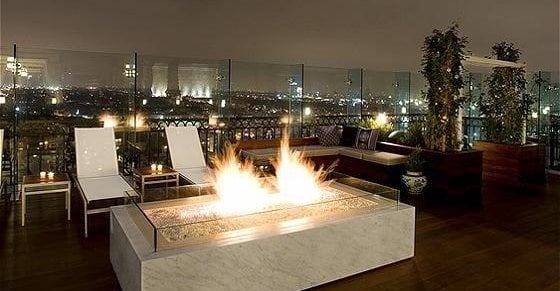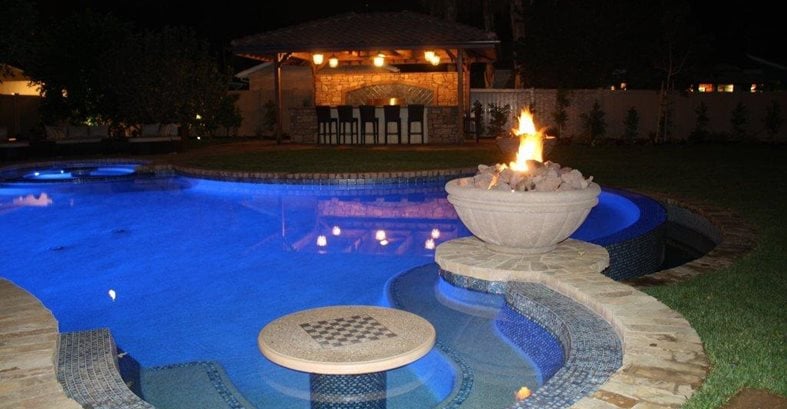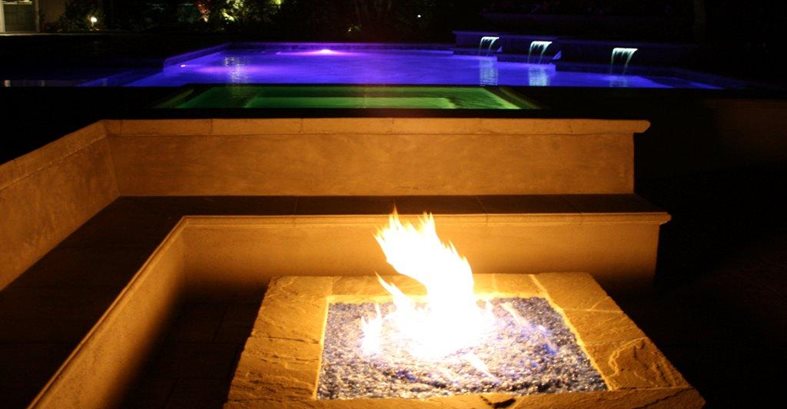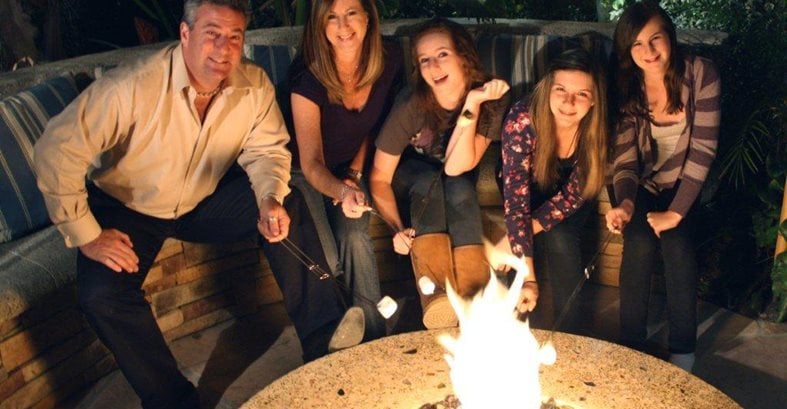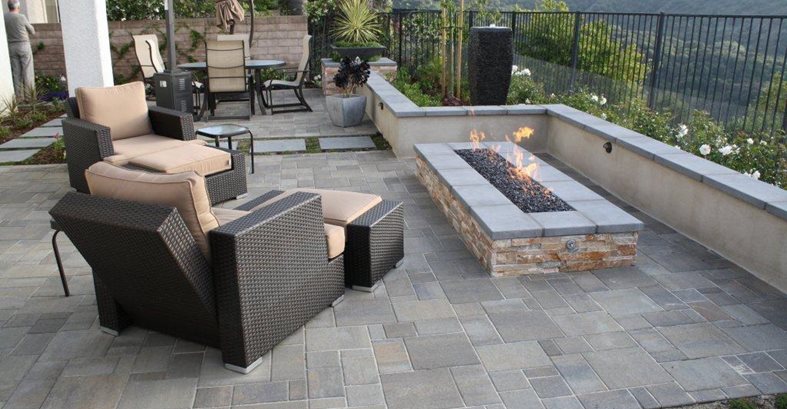- Outdoor Living Space Ideas
- Top trends in outdoor concrete design
- Outdoor room checklist (PDF)
- Fire Pit or Fireplace?
- Ways to Enhance Outdoor Rooms
- Outdoor fireplaces
- Fire pits
- Concrete fire bowls and tables
- Outdoor kitchens and countertops
- Seat walls
- Outdoor concrete furniture
- Concrete planters
- Backyard Landscaping with Concrete
- Concrete patios
- Concrete curbing
- Stairs and steps
- Concrete walkways
- Concrete garden bridges
- Water features
- Architectural accents
- Concrete statuary
- Backyard Landscaping: Get more ideas from LandscapingNetwork.com
- Backyard Recreation Options
- Concrete pool decks: Design and layout tips
- Concrete tennis courts: Planning and construction
- Other Resources
- Outdoor Decorative Floors
- Free Outdoor Living Catalog
Fire Pit Safety Tips for Hotels, Restaurants and Bars
Outdoor fire pits in public places can potentially cause serious accidents. Proper planning, design and construction can greatly reduce the danger and help you avoid liability exposureMORE FIRE PIT INFO
Fire Pit Design Options: Compare round, square, rectangular and fire hearth designs
For years, fire pits, fire bowls and fire conversation pits have been popular additions to residential backyards. Now they are growing in popularity at hotels, restaurants and bars as a way to create romantic ambiance, provide warmth and light, and encourage conversation and relaxation. Restaurant owners have learned that patrons don’t mind waiting longer for a table while sitting around a fire. And bar and club owners know that the warm glow of an outdoor fire pit prolongs the cocktail hour, which translates into greater profits.
What these business owners often overlook is how dangerous outdoor fire pits can be, especially in a public setting. If the fire feature is not built or managed correctly, guests can literally get burned, resulting in very serious injuries or worse.
I know how potentially dangerous fire features are. As a construction expert witness, I have investigated some incidents where patrons' clothing and hair have caught fire, resulting in months of burn treatments, discomfort, and permanent scarring. These serious accidents often lead to expensive lawsuits to settle the hundreds of thousands of dollars in medical bills. While I can’t comment on the specifics of these burn victim cases, I can help curtail future accidents by sharing important fire pit safety information with the public.
Why Commercial Fire Pits Pose a Potential Safety RiskWhen I wrote the book Outdoor Fireplaces & Fire Pits (available at OutdoorFireplaceDesignIdeas.com), the intent was to share design ideas. I was surprised when I did my research to find very little information on how fire pits should be constructed.
The biggest risk I see is that people often overlook the importance of the height of the flame and weather conditions. Many people tell me they want a “big fire.” They don’t realize that a fire can blow and move out of the fire pit unexpectedly. Most of the time a fire pit is being used for entertaining, and people are relaxing and aren’t mindful of the weather. However, someone’s dress or jacket can easily catch fire if it gets too close to a flame.
At my own home, I have a large outdoor fire pit that I enjoy often with family and friends. When in use, the pit is always supervised by a family member, and we all know the safety rules. The flame height is controlled by a manual keyed valve, and we take into consideration the wind and the number and age of our guests when setting the flame height. We never leave the burning flame unattended.
These same precautions are even more important for fire features in commercial settings, where they are exposed to a larger population. Often the fire pit is left unattended and unprotected from children who might touch the hot coals or toss in flammable material. The wind can pick up unexpectedly and blow flames into the flow of traffic or catch a seated guest's clothing on fire. Additionally, commercial fire pits are often placed in proximity to a bar, and guests may be distracted or inebriated.
It is because of these added hazards that I came up with this list of tips for keeping commercial fires safely contained. By following this advice and using good judgment, you can give your guests all the ambience of an outdoor fire without putting them at risk.
Commercial Fire Pit Safety TipsUse a protective shield: Many architects design commercial fire features with a protective glass or Pyrex shield around the feature, with heights ranging from 8 inches to 2 feet. A clear shield does not distract from the ambiance or warmth of the fire, but it does limit the wind's influence on the fire, provides a barrier to children's hands, and reduces the possibility of clothing blowing into the range of the flame. For indoor and outdoor fireplaces, there is a code requirement for a spark shield, but I am not aware of a code that requires this on outdoor gas burning fire pits.
Control the fire manually: On both commercial and residential projects, I prefer to install a manual keyed gas valve that is match lit rather than an automatic electronic starter. With a manual system, the gas flow is controlled by the use of a brass key set into a valve that governs the amount of gas that flows through the line and regulates the height of the fire. It is the responsibility of the key holder to evaluate current weather conditions and adjust the height of the fire accordingly. The problem with automatic starters is that the flame height is preset and staff may not be trained in how to modify the flames. This is less of a problem if the fire is protected by a glass shield.
Add some distance: Leave at least a 12-inch-wide nonflammable coping around a fire feature. If it is designed as a seating surface, then extend the width to 16 to 18 inches.
Keep it centered: Keep gas rings at least 4 inches away from the edge of the coping to keep flames centered in the feature and prevent overheating of the edge.
Don’t bury the burner: An effect some people like to create with a contemporary fire pit is to use just sand (no glass or lava rock) to produce a very blue, random flame. The danger is that the burner gets buried under 2 to 4 inches of sand and the gas is disbursed unevenly, which can result in the occurrence of flare-ups where they’re not wanted, such as near the edge of the coping where people may be sitting. If you still decide to do this effect, be sure to leave a minimum distance of 1 foot from the gas burner to the coping or edge of the fire feature.
Stay away from traffic: Do not place a fire pit in the flow of traffic. It should be used as a go-to destination or as a focal point and not be adjacent to traffic thoroughfares. It’s better to use torch lighting in those zones if a flame is desired
Establish rules for seating: If you set your fire pit at the industry standard seat height of 16 to 20 inches, then guests are likely to assume that you are inviting them to take a seat by the fire. If this is not your intention or the fire feature is not designed to accommodate seating on the edge, then post "No Seating" signs and make sure guests keep a safe distance.
Mind the weather. Assign personnel to monitor the fire feature and set the flames to accommodate current wind conditions. Wind can rise up quickly and force the fire outside the safety zone of the fire feature. If staff is not available to monitor the weather conditions, install auto shutoff valves that quench the fire automatically when wind speeds exceed a predetermined level.
Prevent accidental explosions: Fire features are often constructed with standard concrete masonry units, which contain aggregate that can overheat and explode, causing serious injury. I recommend installing a protective veneer of refractory fire brick grouted with fire clay.
Take responsibility: In my opinion, it is management's responsibility to monitor fire features and maintain gas ring burners, valves and lines. Guests of public establishments, such as hotels and restaurants, make the reasonable assumption that the space is a safe environment and that special care has been taken to protect visitors from harm. As such, their guard may be down and injuries can result. Make sure personnel are trained on the proper operation and maintenance of the fire feature and the safety hazards associated with wind and crowds. If an accident does occur, personnel should be trained on how to properly use a fire extinguisher and the emergency procedures to follow.
Related:Pool Deck Safety
Author Scott Cohen, "HGTV's Favorite Garden Artisan"Scott Cohen is owner of The Green Scene Landscaping and Pools, a licensed contractor in landscape, swimming pool, and general construction. He offers landscape design, and construction defect expert witness services nationwide, and has served as an expert witness for the CSLB for over a decade.
A 3 time Masters of Design Award winner, Scott has been featured on several television shows and published in numerous local and national print media. He is the award winning author of The Candid Contractor, Outdoor Fireplaces and Fire Pits, Poolscapes, The Big Book of BBQ Plans, Scott Cohen’s Outdoor Kitchen Design Workbook, and Petscaping.
Cohen has been commissioned to present a seminar on Outdoor Fireplace and Fire Pit Design and Construction in North Carolina at the Concrete Decor Show in March 2013.
